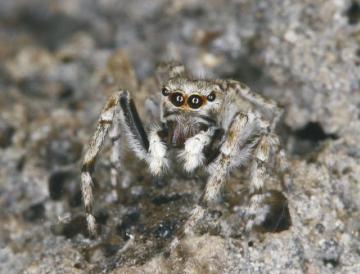Species Account for Sitticus distinguendus
Reproduction for study and non-profit use permitted, all other rights reserved.
No data yet available for this species in this format
View time series maps for Sitticus distinguendus
member log-on for taxon report
Essex RDB: Listed
Threat: Essex Endangered
Images
upload a new image
Essex Red Data List comment
Recorded from West Thurrock Marshes
Species text
Two small males and one subfemale of this spider was first found at West Thurrock North Lagoon in pitfall trap material in September 2003 (Harvey & Hammond, 2003), but was misidentified at the time as Sitticus saltator. The collection of live specimens (males and females) in the same area during 2005 made it clear the spider was not this species and that it was not any other species previously recognised in the British fauna. Dmitri Logunov, an expert in the Salticidae, identified the specimens as Sitticus distinguendus, a species with a Palaearctic nemoral range from France to Maritime Province and Japan, north to Tansk and South Yakutia and south to Shanxi (Logunov & Marusik, 2000). He commented that there are no zoogeographical constrains on this species occurring in Britain (pers. comm.). This suggests that the colony at West Thurrock is the result of natural colonisation of suitable habitat, and it is certainly well established at the West Thurrock site, with a thriving but very restricted colony in dry stony saline habitat at the edges of a large seasonally wet water body and saline edges of adjacent track, with specimens being found in numbers throughout the season. It is also possible that the population has been present for much longer, since a survey in 1996 did not sample the area in which it is located.
The recognition of the species at West Thurrock resulted in the realisation that a single female collected by Tony Russell-Smith in 2004 on a substrate of cement factory flue-ash at Swanscombe Marshes, only 2 kilometres from the West Thurrock site across the River Thames was also this species. In West Thurrock the very localised habitat is dry sparsely vegetated ground close to seasonally wet areas on a substrate of fine almost sand-like PFA and stony clinker that has a distinctly saline character. In the area immediately adjacent to where the spider has been found salt can often be seen encrusted on the surface and plants such as glasswort Salicornia grow. Much of the rest of the site comprises dry flower rich grasslands with plant species associated with calcareous substrates as well as sparsely vegetated sandy areas that provide a mosaic with features of heathland. The character of the habitat where the spider has been found in Britain has distinct similarities to most of its recorded habitats in Europe, for example grey dune vegetation has high affinities with heathland and chalk grassland vegetation and at Boulonnais the grey dunes make contact with chalk grassland (Bonte et al. 2003). Logunov & Marusik (op. cit.) provide the following habitat details for the species: zonal forb-grass steppes, salt marshes, sloping shrub-stony steppes, screes and cobble-gramineous stands, bird cherry stand, stony river banks and taiga edges, larch forests and mountain steppe-semidesert, cliffs and screes. Zabka (1997) describes the habitat as sandy places covered with sparse vegetation and Krasnobayev (2004) describes habitats in some regions of European Russia as upland meadows and pine forests, sandy and creatceous sloping steppes and on riverbanks.
S. distinguendus is listed as Endangered in the Czech Republic (Buchar & Ruzicka, 2002) and in Flanders (Instituut voor Natuurbehoud, 2005), it has a Proposed Red List status of Endangered and Declining in Norway, as Vulnerable in Poland (Zabka, 1997), and there is only one 10km dot in the Spiders of Serbia. It is also regarded as one of the most interesting species from Antwerp (Vanuytven, 1997). In Britain the spider is unlikely to have been overlooked on dune systems or rocky habitats - it is large and males very distinctive in life. The scarcity of habitat, the importance of the population in Western European terms and the high degree of threat have meant that the British Arachnological Society UKBAP Review Panel have proposed the species as an addition to the UKBAP, and this was accepted in the UKBAP review published in 2007. References
Habitats
Why not join the Club, register and add a new species page
Interpretation of distribution maps



















